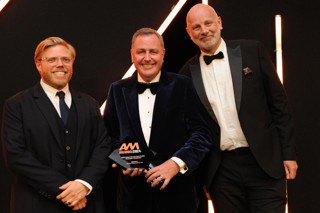This continued as long as we could hide behind restrictive trade barriers but now free trade has exposed us to the full force of foreign competition.
According to conventional wisdom, with the globe an open market only those with global reach will prosper. So globalisation has swept like a tidal wave over the world’s motor industry, drowning the mediocrities in mergers, acquisitions and global consolidation.
Yet research at Cardiff Business School suggests that a major upheaval may be approaching, one in which British companies could find a new role. China is the key, and it might just catapult MG Rover to the top of the pile.
This Chinese induced renaissance will come just in time for MG Rover, and show the way for others too. Cardiff research is putting forward the view that the company could be a catalyst for change throughout the industry.
Punch drunk after years of unremitting decline it seems as if the entire British automotive sector has become little more than a branch factory for the global behemoths that have devoured all rivals. Huge production numbers are seen as the sine qua non and quite simply there is no room in this business for second place. In this industry you count your output in millions or not at all.
There are two factors at play here, production integration and economy of scale. If you imagine a production system from top to bottom you can visualise materials going in at the top and cars pouring out the bottom.
Henry Ford found that his new production flow system depended on a reliable supply of parts to keep it flowing, so he vertically integrated his company by internalising the supply.
Where bodies and engines had been large components that Henry Ford bought in from outside, gradually he took the processes over in his own facilities. This philosophy of vertical integration reached its apogee at plants like Dagenham, iron ore and coal going in at the top and cars pouring out the bottom.
We can summarise the main functions that make up a vertically integrated car company into four distinct activities, as shown by Figure 1. Here we see that the design function instructs the powertrain and body manufacturing functions.
Powertrain comprises the manufacture of engines and gearboxes, which is technically separate from the welding and painting of car bodies in the body production function.
The two manufacturing functions then feed into the final assembly function and from there into the market place. We are not at this stage interested in the size of the operation, TVR are not being distinguished from Toyota, so for the purposes of the Cardiff research programme this structure is known as a full function producer.
Figure 1: Typical Full Function Car Producer

It took Alfred P Sloan of General Motors (GM) to see that this was only part of the story. He knew that it was necessary to match the scale of the operation to the technology of the process in order to achieve efficiency. It is not simply a matter of bigger output being better, more that the arrangement of workforce and machinery has one level of output at which it operates best.
The challenge is to bring each function to the appropriate level and then match it with the other functions to create an overall level of efficiency. This is economy of scale and GM were the first to give it priority with widespread badge engineering and platform sharing. If a full function company does not recognize this need for appropriate output then it will operate with a perpetual cost disadvantage, whether its output is too large or too small.
At the heart of the matter is the all-steel welded body that replaced the separate chassis. From a few sheets of steel the entire car can be stamped out and welded in moments, but the precision made dies that shape the panels cost tens of millions of pounds.
Paying for the investment means that high volume production is not simply an option, it is a necessity. As Professor Garel Rhys of Cardiff Business School has often pointed out, maximum efficiency is gained when annual production reaches about a million pressings, the figure for engines and final assembly being somewhat different.
In the production process for one model the lowest common denominator is set by the body pressing, so the other functions need to be matched to it. This is why manufacturers need to count their production volume in millions, or suffer an inherent cost disadvantage. Only one market in the world could ever support a domestic industry of this size: America. It was here that the auto industry had the space to reach its ultimate scale.
It was only in America where there could be three national champions, the Big 3, knocking them out at a massive and cost effective rate. Even Ford’s disastrous Edsel found over 60,000 suckers in its first year, the kind of numbers that Rover would gladly accept now for the 75.
Outside the US countries hid their infant industries from harsh economic demands behind protective trade barriers. British consumers were oblivious to the industrial perfection of economic scale and we simply paid a premium for the pleasure of having half a dozen domestic companies making broadly similar cars. Austin and Morris sailed through the 1960s on around 100,000 a year for their most popular models, Ford never really filled Dagenham and Rover coasted along in a backwater. We did not know it then, but this was the Indian summer of the British car industry.
When the world began to dismantle the trade barriers from the 1970s every independent manufacturer outside of America was exposed to the crushing cost advantages of the competition.
The Germans were able to delay questions of scale with the excuse that quality came at a premium price that funded the lack of volume, while the Americans could avoid questions of quality by living off the economic advantages of scale. It was the Japanese who took a ruthless pursuit of quality and applied it to the cost advantages of economic scale.
Now that the apparent contradictions of cost and quality have been resolved the rest of the world has to catch up or die. Quality can be addressed internally, but there is no substitute for scale. In those countries that cannot support such a high level of output domestically, and that means practically all of them, the answer is to build for export and destroy the opposition in its home market. The only other alternative is to cheat a little and form joint ventures.
Joint ventures always used to work like this: consider two companies having a problem achieving efficient numbers in a specific area, let’s say it’s in powertrain. Rivals are churning them out at the economic optimum of perhaps a million or so, anything less than that entails economic drag and higher costs. By pooling their resources the two companies can participate in an efficient level of production without taking the huge tactical risk of going for high volume on their own.
Like two drunks leaning on each other this kind of mutual help keeps the two companies lurching in the right direction, but what happens if one partner wants to do something different, or falls on hard times? GM’s deal with Fiat is already unravelling because they just could not keep their strategic plans in harmony.
Figure 2 shows this kind of joint venture relationship, in this example it is in powertrain but it could be in any of the four functions. An example of such a relationship would be that between BMW and Chrysler for the production of small engines in Brazil.
Since the sharing is across the production process the research at Cardiff Business School has categorised it as a horizontal joint venture. It is the most common form of joint venture because it allows the partners to retain the full range of capabilities and they can continue as a full function company. It can be a brilliant tactical move but it also reduces the long term strategic freedom of the companies.
Should the horizontal joint venture become permanent it can stifle one or both of the companies’ future growth. For example, BMW have a horizontal joint venture in final assembly with Brilliance China, the company that was previously slated as MG Rover’s Chinese partner. BMW picked up the deal but they now find that production capacity is limited to 30,000 year at the most, while Audi race towards 100,000 a year from their Chinese facilities.
BMW cannot be enjoying being held back in this way in the world’s fastest growing market by a partner that is too easily distracted by more questionable investments.
Figure 2: Horizontal Joint Venture in Powertrain Between Two Full Function Companies

It is the transitory convenience of the horizontal joint venture that has prompted the Cardiff research to propose a new kind of relationship: the vertical joint venture. This combines the activities of the two partners to simulate the basic vertical integration of a single full function company. Figure 3 shows how this might work.
Whereas the horizontal joint venture makes a strength out of two weaknesses the vertical joint venture combines complementary strengths and creates a virtual full function company enjoying economic scale in each division.
The idea is that the companies can concentrate on their positive attributes rather than combining the negative ones. In theory, at least, this elevates the partnership to the same level as Toyota, fully integrated and cost effective. For this to work the partners must have the appropriate scale without overlapping capabilities.
A certain amount of this happens in sports car production where the originating companies design new models but lack the facilities that can be economically efficient at low levels of output. Valmet in Finland are almost unknown to consumers even though it is they who produce the Porsche Boxster.
We can be reassured that the Boxster is still an authentic Porsche, simply that the assembly line is operated by someone else.
Figure 3 Vertical Joint Venture

To transfer this approach to volume car production represents a quantum leap in management thinking. It is one thing to hand small scale production to a specialist, quite another to altogether abandon investments in high volume production.
To embark on a vertical joint venture the two partners would have to be sure that they suffered deep seated yet complementary weaknesses that were dragging down their other capabilities.
For example, we would need to find one company without a design function and another lacking production, but in an industry as mature as this it might seem impossible.
Most companies have reached full function status and would be loath to give up their hard won capabilities. Yet with the vast new Chinese market shaking up the industry we find there are two companies that fit this description very neatly: MG Rover and SAIC.
Figure 4 shows how this deal might be shaping up. In terms of production SAIC is operating at a very respectable scale, advancing swiftly towards a million units a year. After the US, China is perhaps the only other country with a domestic market big enough to offer economic scale internally. If SAIC designed its own cars it would have the potential to challenge Toyota.
The trouble is that the production is all for VW and GM, two companies with plenty of overcapacity elsewhere in the world. They only work with SAIC in this horizontal joint venture because the Chinese government has forced them to, it is a purely tactical move.
Far more preferable for them would be to have their own factories, and once they are allowed to do this SAIC will swiftly find itself on the scrap heap.
MG Rover, on the other hand, desperately needs scale in production and even with a new range of cars it would take them decades to get there. Despite the criticism of cynics the company is as capable as any of designing world class mass market cars, the rear wheel drive 75 platform being a showcase for their talent.
That they were able to do it so quickly and cheaply reveals an economy of scale in design previously undefined in the industry. Working together with SAIC in a vertical joint venture the two partners can capitalise on their individual scale advantages and create the perfect production process.
Figure 4 Vertical Joint Venture between MG Rover and SAIC

But this new business model is not about wishful thinking, it is highly predictive and has some very tough implications. The most ominous is that the theory predicts that volume production at Longbridge must end in favour of Chinese production.
The opportunity in China is for high volume production, the very area that MG Rover has suffered in. There are already rumours that the current Rover 25 will move there and it is unlikely that its successor will return to the UK except as an import.
The current 45 will probably stay here for the time being but only because it is soon to be superseded, and then the new car will be an ideal candidate for Chinese only production too. The higher income yielding 75 can justify UK production and Longbridge might even specialise in those variants that would not be so popular in China, such as estates and coupes. The MG sports cars, the TF and SV, are unlikely to be made in China and might not be included in the vertical joint venture deal at all.
So what we are likely to see at MG Rover is a much diminished production side but a greatly enhanced design capability. In line with the theory there are already rumours of mass redundancies on the shop floor while simultaneously the company is said to be advertising for 200 new engineers.
Confirmation of the stories will come out periodically, but the media will be denied much in the way of headline grabbing news. As a vertical joint venture SAIC do not need to buy MG Rover and they will avoid tying up their cash in an operation where they have no experience.
We should be aware that as far as SAIC is concerned MG Rover is the goose laying golden eggs, it is the task of the Chinese to make them hatch. We are unlikely to see dramatic transfers of cash to pay for model development, although over time the funds will need to be paid. Model development is gigantically expensive, a complete programme consuming a billion pounds or so, but this will come by instalments as it is required and not necessarily upfront.
Rival companies will be fascinated to watch the show unfurl. Ford absorbed Jaguar looking for skill in designing premium sector cars, but at the same time lumbered themselves with uneconomic factories. A vertical joint venture would have given Jaguar design authority over all Ford’s premium saloons, including any badge engineered variants such as Lincoln, in return for handing production responsibilities to Ford.
We can see Ford grasping this nettle now with the closure of Browns Lane, but according to the theory this is too little too late and transfer of S-Type production to the US cannot be far away.
The vertical joint venture would not suit many companies, only those with a strong talent in distinct areas but lacking the overall scale in all functions to sustain long term independence. It would not have saved Saab from being dissolved into GM, the parent company already had most of what the Swedes could offer.
MG Rover and SAIC complement each other in distinct and complete areas, thus showing a possible future for Bentley, Rolls-Royce, Mazda, Alfa Romeo and so on. Sadly, it is probably time to ring last orders for Saab, Lancia and Proton.

Author: Michael Wynn-Williams, Cardiff Business School

















Login to comment
Comments
No comments have been made yet.